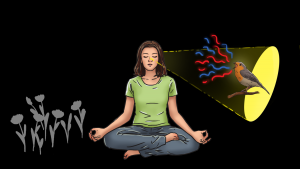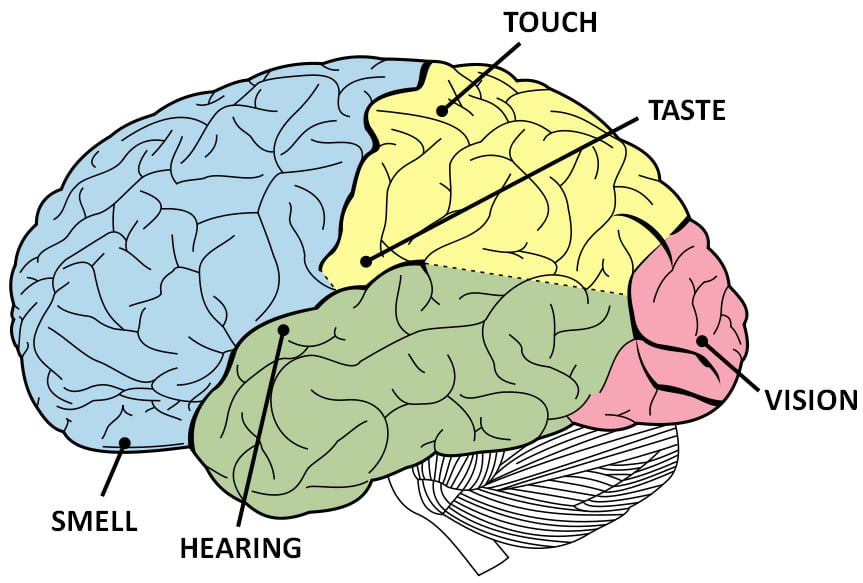Senses in relationship to parts of the brain (Source)
Billy Joel isn't the only well-known person who has this experience. Some of the most creative people in the world owe it in part to this condition. John Mayer, Kanye West, Alessia Cara, Billie Eilish, Beyonce, and Duke Ellington were just a few of the well-known people with synesthesia. Imagine having a four-dimensional outlook on everything--it could be life-altering. As someone who loves colors and music, I think being able to have an ability similar to these people would be wonderful. But there are some things I wonder about...
I often question if everyone can see the same colors. Let's say when I look at "grey," I see what we would consider as blue. But, when my friend looks at "grey," she actually sees what we consider green. If this happened for every color, we could never really know. Because we would all be defining our own colors. It also could partially explain people's tastes in fashion, art, and more. While this isn't synesthesia, we know for a fact that synesthetes have a similar experience. When I look at grey and see grey, a synesthete could see grey while hearing jazz music. Everything is more enhanced. I wish there were some kind of glasses or machine that could allow us to experience synesthesia. Look later in this post where I find out there actually IS a way (and it's not drug-related).
Not only that, but there are over 80 official types of synesthesia. One new form I read about is "Mirror-touch" synesthesia: when you see someone touched, you feel the sensation of being touched yourself. There's also "mirror-pain" synesthesia: when you can feel other people's pain. I feel like that would be very difficult to live with and gives a whole new layer to being empathetic.

Synesthesia meditation (Source)
If you really want to experience synesthesia, like I do, there is one possibility: meditation. Studies show that the best way to cultivate synesthesia isn't through something like LSD, but actually through meditation. I think I know what I'm going to do this summer!
"A Mango-Shaped Space" book cover (Source)
I first learned about synesthesia in middle school when I read a book called A Mango Shaped Space by Wendy Mass. It's about a young girl, Mia, who has a severe version of synesthesia, and how she comes to understand and appreciate her differences. While that synopsis sounds cheesy, it was incredibly interesting. One of my favorite parts is when she recounts the first time she realized that not everyone was like her. Mia's synesthesia meant that she could see a color with a number. It kept her from completing more complex math problems. Additionally, Spanish words had different colors than their English translations, making school incredibly difficult. I loved reading this book because it gave me my first insight into the synesthete experience. How a synesthete could see numbers and letters (Source)
So, do you have synesthesia? I'm pretty sure I don't. But, maybe you do! You can find out by taking one of the tests in this link. But synesthesia can often be very subtle. So, there's a chance you have it and may never realize, even if you do take that quiz.
Not only that, but there are over 80 official types of synesthesia. One new form I read about is "Mirror-touch" synesthesia: when you see someone touched, you feel the sensation of being touched yourself. There's also "mirror-pain" synesthesia: when you can feel other people's pain. I feel like that would be very difficult to live with and gives a whole new layer to being empathetic.

Synesthesia meditation (Source)



This topic is fascinating. I have wondered what it would be like to experience something as unique as this. I'll have to join you in the mediation!
ReplyDeleteI have heard about this before and always thought that it was so fascinating! It would be so cool to be able to experience it.
ReplyDeleteThis is so cool and I had no idea it was so common. I think it makes sense that meditation could allow you to rework your brain to develop synesthesia
ReplyDeleteI took the quiz and I don't have it :( Wish I did though, seems so cool.
ReplyDeleteI do not think I have this, but it is a very interesting phenomenon. The human brain is fascinating and always has new miracles to reveal. Very interesting topic!
ReplyDelete